|
Jewish Prague
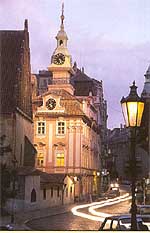 The
Jewish quarter is a small area known as Josefov between the Old
Town Square and the Vltava River. The
Jewish quarter is a small area known as Josefov between the Old
Town Square and the Vltava River.
Most of it can be walked through
and around in a single day but any detailed explorations needs time.
The Jewish cemetery, Old-new synagogue, Klausen Synagogue and the
Pinkas synagogue are the most worthwhile sights.
Be prepared for
entrance fees at several of the sights.
The history of the area
dates back to the 11th Century.
Though the Jews of this time prospered
and coexisted in relative peace with their neighbours, the crusades
of the 11th century were to bring a tidal wave of sorrow.
While
en-rout to the Holy Land, the crusaders massacred the Czech Jews
and plundered their properties.
Those who survived were forcibly
converted to Christianity.
In this period, several significant changes
were imposed on the remaining Jewish communities.
Their synagogues
were burned to the ground, their civil rights were severely limited
and they were forced to build their community on the right bank
of the Vltava only, thus limiting their movements and clearly identifying
their minority group.
This was the beginning of what later came
to be known as the Jewish ghetto, an area which today is frequented
by tourists.
Among the many atrocities through the centuries committed
on the Jews that, of the Nazi era was to have the most devastating
effect.
At this time there were an estimated 56,000 Jews residing
in Prague alone.
Only 10% of the country's entire Jewish population
would survive the German occupation.
Most were first sent to the
prison camp of Terezin (60 km North West of Prague) which today
stands as a memorial museum and is open to the public.
The size
of the Jewish community left in the Czech Republic and Prague today
is difficult to estimate.
After having been one of the largest Jewish
communities in Europe, they are now among the smallest.
The history
of the Czech Jews has been unique and tragic, leaving behind proof
of their historical significance to this part of Europe, which can
be visited to this day.
Since the collapse of Communism the Synagogues
of the old town seem to have been re-awakened and new activity by
the local Jewish community growing.
Several Jewish organisations
have been formed, buildings renovated and kosher restaurants reopened.
A sign, we hope, of the comeback of a people.

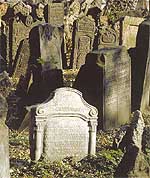
The Old Jewish Cemetery can be visited Mon-Fri and Sun.
The cemetery
is an eerie plot of land, piled with gravestones in all manner of
positions, dating back to the 15th century and was in use until
18th century.
However, the present day cemetery - consisting of
thousands of bodies, layer upon layer, in a topsy-turvy heap - originates
from the end of the 17th century and beginning of the 18th century.
During this period Jews were forced to live crammed together in
the small area now known as Josefov which then amounted to no more
than a ghetto.
The 'ghetto' walls were finally pulled down (mid
to late 18th century) and Jews left to live in relative prosperity
as crafts men and traders until the devastating Nazi era.
The cemetery
lies adjacent to other Jewish sights, all of which are open to visitors.

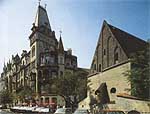 Dates
back to the middle of the 13th century, which means that this is
the oldest synagogue in Central Europe, the gates themselves are
the oldest in Prague. Dates
back to the middle of the 13th century, which means that this is
the oldest synagogue in Central Europe, the gates themselves are
the oldest in Prague.
The early Gothic style gives you an idea of
how many of the buildings once looked like.
There are many legends
about this building.
One of them claims that angels came with the
stones from which the synagogue is built and have protected it ever
since (unrelated or not the synagogue has avoided two big fires).
The synagogue was renovated in the 19th century and is used for
religious services.
Notice the separation of men and woman. During
the service the synagogue itself is reserved for the men, while
the women must follow the service through small windows in the wall.
The synagogue is still in use.

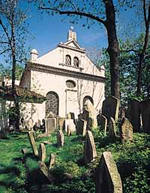
Now a small
museum of Jewish culture displaying art and artefacts including
paintings, combs, books and some fine torah crowns.
Perpendicular
to the synagogue is the building of the Prague Burial society,
which holds a large collection of paintings of Jews who were
held at the Terezin concentration camp and a series of children
drawings illustrating the same.

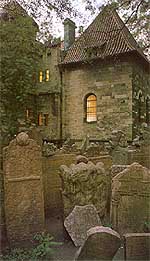
The story goes that Rabbi Pinkas apparently had
a dead monkey thrown through his window.
However the pranksters
did not know that the monkey had swallowed some gold coins belonging
to its master who was a goldsmith - the monkey had been trying to
imitate the master biting the coins for authenticity.
Rabbi Pinkas
noticed that the carcass was unusually heavy and so cut it open
to find all the coins.
He dedicated the gift to the building of
this synagogue.
Story aside the Pinkas Synagogue today is the gateway
to the Jewish cemetery.
During communism the building was closed
for restoration, during which time all the names of holocaust victims
inscribed on the walls were unfortunately erased.
However a new
project endeavoured to restore all 77,927 names to their rightful
place and they now cover the entire interior of the nave.

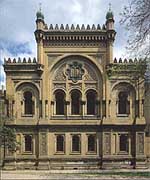
Built on the outskirts of what was the Jewish ghetto
in 1868, is was a house of worship for an increasing number of Reform
Jews. Its fa¯ade is a rich expression of Moorish architecture.

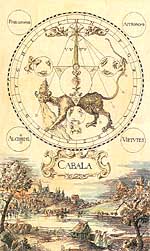
Golem
is a Hebrew word, which has been translated in several ways : embryo,
primitive matter, unformed matter, man without intelligence, manners
and morals to name a few.
The fascination Jews have with the possibilities
of animating lifeless matter, as the creater himself did, are evident
in the texts and teachings of the Kabbala.
With the help of the
appropriate ritual and the secrets prescribed by the texts it is
possible to create a soulless human or creature from simple primitive
matter such as clay.
Hence the Golem in Prague, which has grown
to mythical proportions, was created by Rabbii Loew out of clay
but has unfortunately got loose and to this day runs amok somewhere
in Prague ; some say it resides in the rafters of the Old/New synagogue.
Few might be able to tell you the true origin of the story as the
superstitious speculations of so many visitors to Prague has caused
the story to take on every conceivable shape and fancy.

|